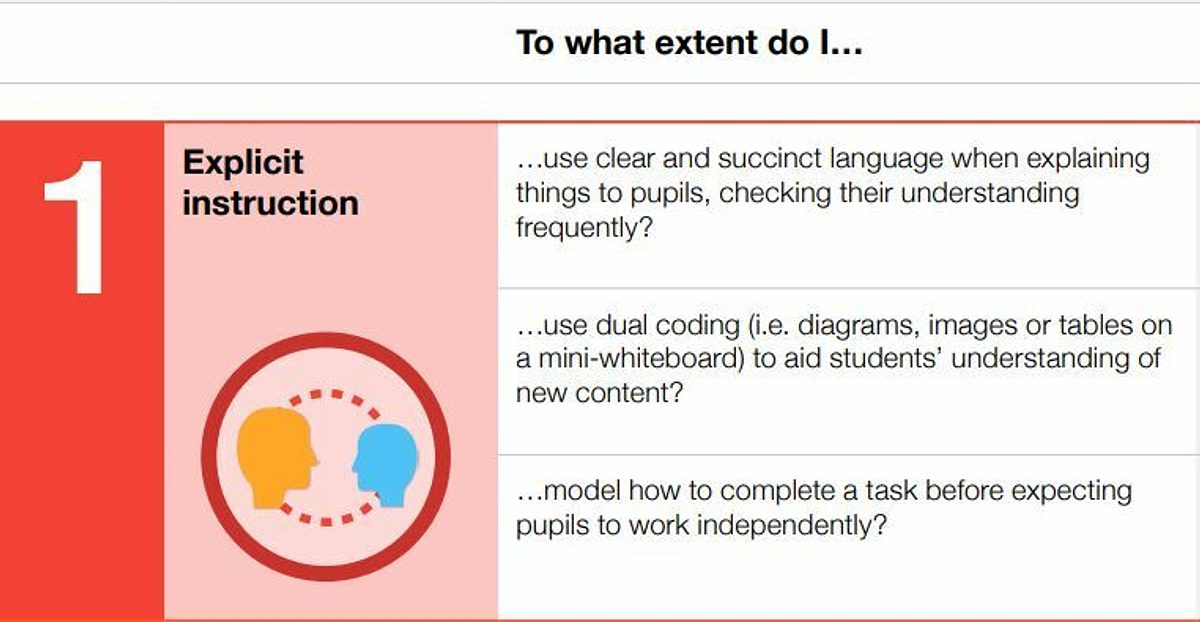
EEF’s Special Education Needs in Mainstream Schools guidance report
Explicit teaching can sometimes be caricatured as ‘chalk and talk’, with the onus on the teacher to ‘deliver’ with too little notion of the needs of pupils.
The research evidence on supporting pupils with Special Education Needs and Disabilities (SEND) in mainstream classroom tells another story. Supporting pupils with SEND should be part of a proactive approach to supporting all pupils, not an ‘add on’.
In ensuring all pupils have access to high quality teaching, the EEF’s evidence around explicit instruction may provide a useful point of reflection and could be particularly purposeful for pupils with SEND.
What is ‘explicit instruction’?

What can explicit instruction look like in practice?
The EEF’s SEND in Mainstream guidance report shares the following teaching habits as important tenets of explicit instruction:
• teaching skills and concepts in small steps;
• using examples and non-examples;
• using clear and unambiguous language;
• anticipating and planning for common misconceptions; and
• highlighting essential content and removing distracting information.
Explicit instruction is one of a group of five teaching strategies that we can consider emphasising for pupils with SEND – a ‘Five-a-day’ – that emerge from one recommendation within the EEF’s guidance report, Special Educational Needs in Mainstream Schools, to support pupils with SEND.
How strong is the evidence for ‘explicit instruction’?
The EEF’s evidence review identified four systematic reviews (Dessemontet; 2019; Afacan, 2018; Hudson, 2018; Hwang, 2018), incorporating a total of 116 studies, that supported explicit instruction as a helpful approach for pupils with a range of SEND. They also reference the University of Florida’s High-Leverage Practices document, which gives the following helpful definition of Explicit Instruction:

Within explicit instruction, there are clear overlaps with ‘adaptive teaching’, particularly the references to checking understanding and asking questions frequently. By building in opportunities for feedback throughout a lesson, teachers are better able to adapt their teaching as they go, to ensure greater pupil understanding.
Teachers might think about whether their current practice has enough steps to support the journey from teacher exposition to independent practice. Are there middle steps, in which learning is guided, co-created or modelled to support all pupils, but particularly pupils with SEND?
As with any approach, there are potential pitfalls to be aware of. It will be important that teachers don’t move pupils to independent practice too soon, but move towards independence in steps.
That said, independence should still be the aim for all. Practising securely-learned content, with as much independence as possible is essential for embedding learning.
References
Afacan, K., Wilkerson, K. L., & Ruppar, A. L. (2018). Multicomponent Reading Interventions for Students With Intellectual Disability. Remedial & Special Education, 39(4), 229 – 242. doi:10.1177/0741932517702444
Council for Exceptional Children & CEEDAR Center. 2017. High-Leverage Practices in Special Education. Accessed at https://bit.ly/3ZQGsRt, 16.03.23
Dessemontet, R.S., Martinet, C., de Chambrier, A‑F., Martini-Willemin, B‑M., Audrin, C. (2019). A meta-analysis on the effectiveness of phonics instruction for teaching decoding skills to students with intellectual disability, Educational Research Review, 26, 52 – 70.Rosenshine, B. 2012. ‘Research-Based Strategies that all Teachers should know’, American Educator, Vol. 36, No.1, Spring, pp. 12 – 19, 39.
Hudson, M. E., Rivera, C. J., & Grady, M. M. (2018). Research on Mathematics Instruction with Students with Significant Cognitive Disabilities: Has Anything Changed? Research and Practice for Persons with Severe Disabilities, 43(1), 38 – 53. doi:10.1177/1540796918756601
Hwang, J., Riccomini, P. J., Hwang, S. Y., & Morano, S. (2018). A Systematic Analysis of Experimental Studies Targeting Fractions for Students with Mathematics Difficulties. Learning Disabilities Research & Practice, 34(1), 47 – 61. doi:10.1111/ldrp.12187
The EEF website also offers a reflection tool for teachers to consider their own practice in light of the ‘Five-a-day’ approach, asking questions that break down each of the 5 evidence-informed teaching techniques.
